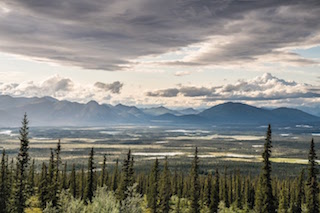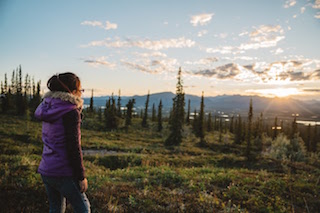 The just released short film, The Refuge, focuses on the Gwich’in people of Alaska and Northern Canada and their more than three decade fight to protect the Coastal Plain of the Arctic National Wildlife Refuge from oil drilling and other threats. Filming in such a remote location was severely challenging. As there are no cars in Arctic Village, bulky film equipment had to be transported by ATV or carried on foot. Electricity was also at a premium. Directors Kahlil Hudson and Alex Jablonski had access to just one electrical outlet for use in charging camera equipment and computers.
The just released short film, The Refuge, focuses on the Gwich’in people of Alaska and Northern Canada and their more than three decade fight to protect the Coastal Plain of the Arctic National Wildlife Refuge from oil drilling and other threats. Filming in such a remote location was severely challenging. As there are no cars in Arctic Village, bulky film equipment had to be transported by ATV or carried on foot. Electricity was also at a premium. Directors Kahlil Hudson and Alex Jablonski had access to just one electrical outlet for use in charging camera equipment and computers.
The film focuses, in particular, on the story of two Gwich’in women who are helping to lead the effort to save their ancestral home and the wildlife on which their life depends. It was produced by outdoor apparel company Patagonia.
“I was honored to work on The Refuge with Alex and Kahlil,” said Monika McClure, film and video producer for Patagonia. “They brought so much depth to the project through their beautiful cinematography and gift for storytelling.”
For the film, Hudson and Jablonski traveled with the two women from Fairbanks to Arctic Village, on the southern edge of the Arctic National Wildlife Refuge, for a biennial Gwich’in Gathering. There they documented the group’s ancient rituals and the subsistence lifestyle that they have practiced for more than 20,000 years. “It was stunning to encounter an untouched wilderness; there is so little of that left in the world,” recalled Jablonski. “It was also a revelation to learn about the Gwich'in' and how closely their lives are entwined with the land.”
 During their week in Arctic Village, Hudson and Jablonski kept their filmmaking work as low key as possible even as they lived with the group and took part in their activities. “They’re very inclusive people,” said Hudson. “Everyone ate together, danced together and sang together. It’s a very different type of filmmaking when you are taking part in the experience you are recording, but that is what I appreciated most about it.”
During their week in Arctic Village, Hudson and Jablonski kept their filmmaking work as low key as possible even as they lived with the group and took part in their activities. “They’re very inclusive people,” said Hudson. “Everyone ate together, danced together and sang together. It’s a very different type of filmmaking when you are taking part in the experience you are recording, but that is what I appreciated most about it.”
The pair brought in a bush pilot with a homemade aircraft to capture aerials of the spectacular and unspoiled environment. In particular, they wanted to capture the sun rising over the vast expanse of snow and trees, but the length of summer days in extreme northern Alaska made that difficult. The sun did not set until after 1 a.m. and rose less than three hours later.
A break in the weather toward the end of the week provided the opportunity they had been waiting for. “We got up, put the camera on the bush plane and flew out at 4:30,” said Hudson, “and we hit perfect light. It was coming in sideways through thick clouds and illuminating the most beautiful language you’ve ever seen.”
“It became the transcendent moment in the piece that gives people a sense of what that place is like,” added Jablonski.
The Refuge was recently screened at The Smithsonian Institution National Museum of the American Indian. The film is being promoted in U.S. retail stores and through email marketing. It can be viewed on the Patagonia website at http://www.patagonia.com/the-refuge.html
Hudson hopes the film will make an impact on the future of the Refuge and the ongoing struggles of native peoples to secure their rights. “I hope we’ve done justice to the Gwin’ich,” he said. “It is humbling to come in at the 11th hour after the tribe has been fighting to preserve their way of life for more than 30 years.”
Hudson and Jablonski are represented for commercial projects by Los Angeles-based Accomplice Media. The film was produced by Finback’s Tyler Hughen.
Accomplice Media http://www.accomplice-media.com/
